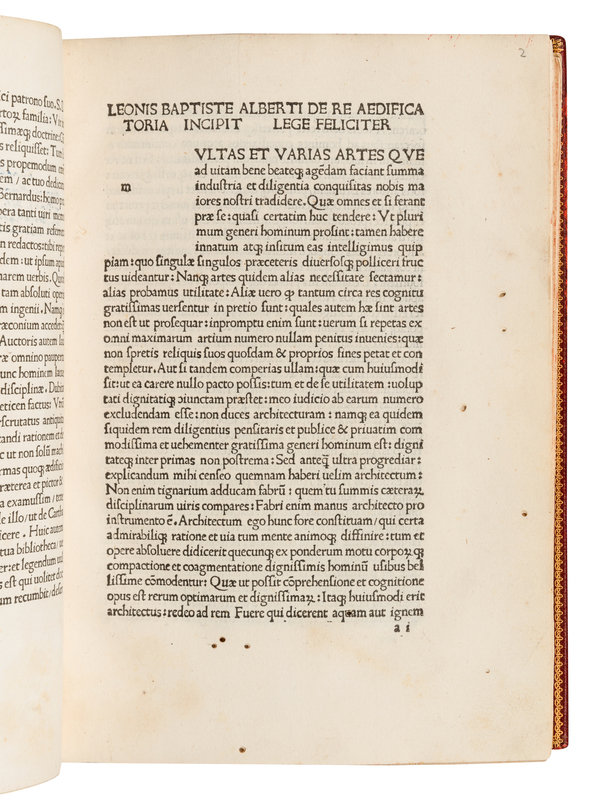Lot 91
ALBERTI, Leon Battista (1404-1472). De re aedificatoria. Florence: Nicolaus Laurentii Alamanus, 29 December 1485. FIRST EDITION OF THE FIRST PRINTED TREATISE ON ARCHTECTURE, presumed earlier setting.
Sale 1022 - Fine Printed Books & Manuscripts, Including Americana
May 4, 2022
9:00AM CT
Live / Chicago
Own a similar item?
Estimate
$80,000 -
120,000
Price Realized
$100,000
Sold prices are inclusive of Buyer’s Premium
Lot Description
ALBERTI, Leon Battista (1404-1472). De re aedificatoria. Florence: Nicolaus Laurentii Alamanus, 29 December 1485.
Folio (262 x 187 mm). Collation: a-d8 e6 f-o8 p6 q-z8 &8 Ɔ8♃8 (a1r blank, a1v dedication to Lorenzo de'Medici, a2r text, ♃7v colophon, ♃8r verse to the reader by "Baptista siculus," ♃8v registrum). 204 leaves, 34 lines. Type: 111Rb. 6- and 7-line initial spaces with printed guide- letters. (Small mostly marginal worm-holes to ca 55 leaves at beginning and end occasionally touching letters, mostly marginal spotting.) 20th-century red morocco gilt (some light wear, a few sheets trimmed affecting marginal annotations). Provenance: Marginal annotations in a Renaissance hand; numerous spurious marginal notes and diagrams in a later "Leonardesque" styled hand in mirror-writing and with diagrams based on his codices (see below); William Marquess of Lothian (armorial bookplate); Emil Richter, Berliner Museum (note in ink on recto of ff.1, see below); acquired by a private individual in 1951; by descent to present owner.
FIRST EDITION OF THE FIRST PRINTED TREATISE ON ARCHTECTURE, presumed earlier setting, with the last quire set in Roman letter as throughout (not Nerlius, see BMC). According to Fowler, Alberti began work on his treatise in the middle of the 15th-century and enhanced and revised the work until his death in 1472. Some thirteen years later, his work was published due to the efforts of his brother. Alberti, who was architect of several important Renaissance buildings including the Basilica of San Sebastiano and Sant'Andrea in Mantua, and the Santa Maria Novella and the Rucellai Palace in Florence, based his work, based on Vitruvius's De Architectura, is divided into ten books describing the building of palaces and churches, and describing materials, construction, and ornament for sacred and secular buildings, as well as a section devoted to the restoration of buildings.
"In accordance with classical principles, the principal elements of architecture are defined as beauty and ornament. Beauty is essentially harmony, the correct proportions of the parts" Alberti considers architecture not only for ecclesiastical purposes or private patrons, but for the first time particularly as a civic activity. His book includes a scheme for building a whole new town, the earliest printed example of town planning" (PMM).
With spurious marginal annotations and drawings in brown in a "Leonardesque" hand on 8 leaves (occurring on ff. 7r, 21v, 30v, 44v, 76v, 131r, 164r and 203v), the last being signed "Leonardo da Vinci." A 24 April 1924 note in German from Emil Richter, the Berliner Museum, describes the annotations as being in the hand of Leonardo da Vinci ("kamm ich Betätigen dass diselben in eigener Hand von Leonardo da Vinci sind"). Though the handwriting and method of writing do bear some similarity to that of Leonardo (including the use of mirror-writing), the drawings, including a partial sketch of a hygrometer, are apparently copied from known examples by Leonardo, and the inscriptions are possibly later.
BMC, VI, 630; BSB-Ink A-125; Cicognara, 370; Fowler 3; Goff A-215; GW 579; HC 419; Millard Italian 4; PMM 28.
Property from the Estate of Nancy Hagensieker
Condition Report
Contact Information
Auction Specialist



